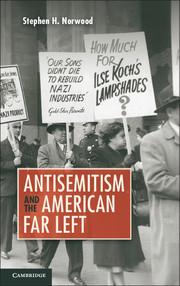Book contents
- Frontmatter
- Dedication
- Contents
- Photos
- 1 Promoting a Socialism of Fools
- 2 American Communists’ Tangled Responses to Antisemitism and Nazism, 1920–1939
- 3 World War II
- 4 Abandoning Assimilation
- 5 “Two, Four, Six, Eight, We Demand a Jewish State”
- 6 “Fiends in Human Form”
- 7 The Jewish Question Discarded
- 8 Shaping the Next Generations
- Notes
- Bibliography
- Index
4 - Abandoning Assimilation
Communist Resistance to Antisemitism and Celebration of Jewish Culture in the Immediate Postwar Period
Published online by Cambridge University Press: 05 June 2014
- Frontmatter
- Dedication
- Contents
- Photos
- 1 Promoting a Socialism of Fools
- 2 American Communists’ Tangled Responses to Antisemitism and Nazism, 1920–1939
- 3 World War II
- 4 Abandoning Assimilation
- 5 “Two, Four, Six, Eight, We Demand a Jewish State”
- 6 “Fiends in Human Form”
- 7 The Jewish Question Discarded
- 8 Shaping the Next Generations
- Notes
- Bibliography
- Index
Summary
COMBATING RESURGENT ANTISEMITISM IN THE WEST
Expecting class conflict to intensify in the West, the Communists discarded the Popular Front strategy when World War II ended and adopted a more strident and sectarian approach. In early 1947, the CP magazine Jewish Life compared the situation in the United States to Germany’s shortly before the Nazis came to power. It predicted that “a major economic crisis” was imminent. Big business would exploit the crisis to assume control over the state. The large manufacturers and financiers would disseminate antisemitic and racist propaganda to confuse and divide the working class, allowing them to install a fascist dictatorship to maintain their profits. Jewish Life cited the postwar emergence of antisemitic, neofascist groups like the Columbians and a revived Ku Klux Klan, along with continuing street assaults on Jews, as evidence that the United States was moving toward fascism. Ben Gold, Communist president of the International Fur and Leather Workers Union, called the 1947 Taft-Hartley “slave labor bill,” which Congress passed over President Truman’s veto, “the beginning of a police state.” Promoted by William Z. Foster, who became CP chairman in 1945, this apocalyptic perspective became known in the party as “the five minutes to midnight line.” As in the Third Period, the CP rejected alliances with socialists, often even conflating them with fascists.
- Type
- Chapter
- Information
- Antisemitism and the American Far Left , pp. 84 - 115Publisher: Cambridge University PressPrint publication year: 2013



